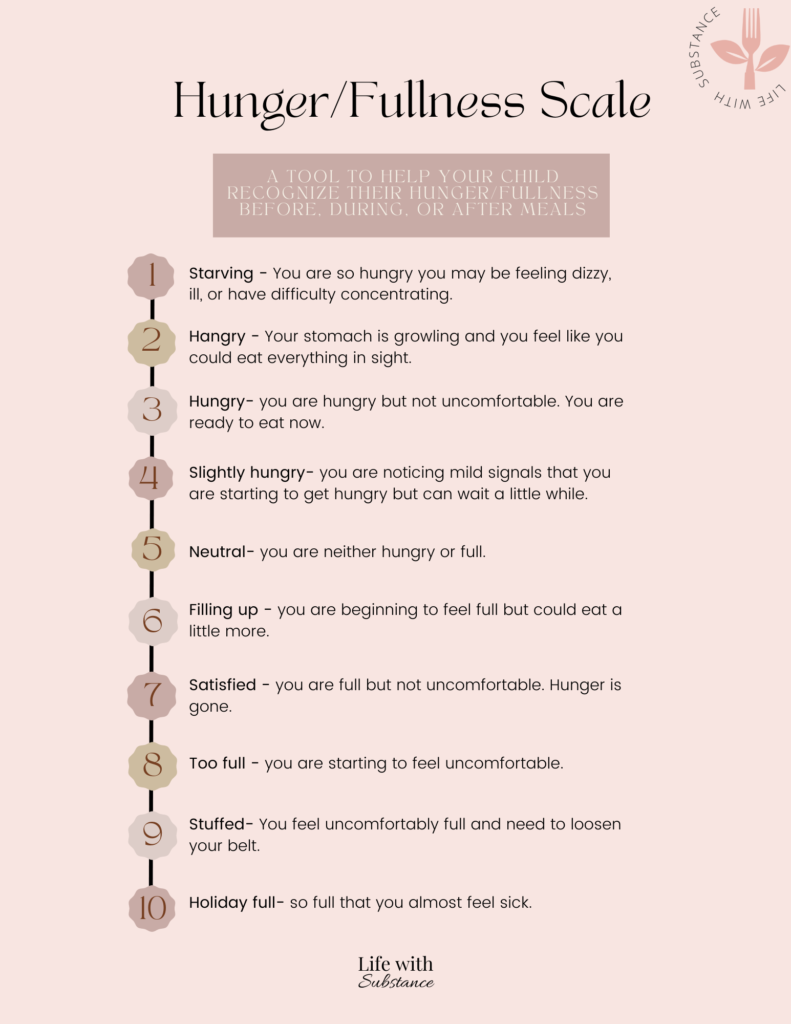This post may contain affiliate links. If you shop from one of our links, we may earn a commission.
Feeding kids is hard, especially with the ever-changing food preferences, mealtime battles, and picky eating struggles. As parents, we feel so conflicted about how to raise our kids to have healthy eating habits due to mixed messages in advertising. Out of desperation to have our kids eat a variety of foods we turn to bribery and force-feeding, which only results in poor eating behaviors and an unhealthy relationship with body image in the long run. Discover how intuitive eating can improve your child’s eating habits.
Intuitive Eating
Maybe force-feeding or bribery is how you were raised to eat and that’s all you know how to do with your own kids. Or maybe you too are struggling with your own relationship with food and body and are at a loss for how to stop the cycle with your family. Just know you’re not alone. Diet culture leaves most parents feeling exhausted, confused, and frustrated. Unfortunately, the world of nutrition often puts healthy eating in a box, stating foods are “good” or “bad” and if you don’t eat a specific way then you are considered “healthy” or “unhealthy.” As a result, we feel that if our kids don’t follow those same rules then they are deemed “healthy” or “unhealthy.”
Thankfully there has been a major shift over the past decade in regards to how dietitians are teaching families to go from a “eat a specific way to have the body you want” to a mindset of “become an intuitive eater and love the body you’re in”. As a registered dietitian that means going away from the idea that an individual must be at a specific body weight to be healthy and focus more on body acceptance and eating in relationship to internal cues of hunger and fullness.
What is Intuitive Eating?
Intuitive Eating (IE) was developed by non-diet dietitians Evelyn Tribole and Elyse Resch in 1995 when they published the first version of their book Intuitive Eating. Their highly researched and evidence-based approach discusses how to have a more innate relationship with food as we have become deterred from it due to external influences and pressures. Intuitive eaters are able to listen to their internal cues of hunger and fullness as a way to guide their eating decisions. Intuitive eaters can approach food with curiosity, honor their hunger and fullness cues, and reject the diet mentality. IE is made up of ten principles listed below.
Intuitive Eating versus Eating Intuitively
Eating intuitively is often confused with IE but it is one concept of IE. For example, we are all born to eat intuitively but lose touch with this as we age. Infants are the best intuitive eaters; they cry when they are hungry and turn their heads once they feel content. As we age we eat less intuitively due to external influences. For example, as a child, you may have gone to the doctor to get a shot. The doctor gave you a sucker to reward you and relieve the pain. In turn that taught us that food is a reward and a way to cope with sadness. Food is used in countless ways today:
- Your kid wins a basketball game so you celebrate with pizza
- Your child passes a hard test so you celebrate with ice cream
- Your son falls and scrapes his knee so you soothe him with a warm cookie
- Your child is bored in the summer and doesn’t know what else to do other than raid the fridge
All of these scenarios teach our children emotional eating rather than eating due to hunger cues. Let’s break down the ten principles that make up IE developed by Elsye Resch and Evelyn Tribole.

Reject the Diet Mentality
Get rid of the diet books and magazines that provide false hope that weight loss is an easy process that can happen quickly and permanently.
Honor Your Hunger
Allow your body to be nourished with an appropriate amount of food to prevent binge eating. Discovering how to honor this biological signal allows you to rebuild trust with food and yourself.
Make Peace with Food
Stop restrictions and give yourself permission to eat. When food is restricted it creates intense feelings of deprivation that lead to overeating when given the opportunity.
Challenge the Food Police
Avoid thoughts from the Food Police that state you are “good” for following specific diet rules and “bad” for allowing yourself a slice of dessert.
Feel Your Fullness
Pause to listen to your body’s feeling of fullness and observe how the food tastes.
Discover the Satisfaction Factor
Discover the pleasure of eating foods you enjoy in an environment that is inviting. Through this eating experience, you will find that you do not require as much food in order to be satisfied.
Cope with Your Emotions Without Using Food
Find ways to cope with emotions rather than turning to food. As we manage feelings of anxiety, stress, boredom, etc we turn to food to fill the void only to find food is unable to fill it.
Respect Your Body
Each of us was created to have a specific body type and should learn to love and respect the body we are in.
Exercise- Feel the Difference
Avoid exercise as a way to burn calories, rather focus on the physical health benefits it provides such as increased energy levels and improved mood.
Honor Your Health-Gentle Nutrition
Aim for a diet that honors your health and taste preferences while allowing you to feel good. Remember, you don’t need to follow a specific diet in order to be healthy. Consider what you eat consistently rather than in just one meal or snack. Progress, not perfection is the goal.

How does Intuitive Eating apply to kids?
Following the Division of Responsibility by feeding expert Ellyn Satter, we learn that parents are responsible for providing what to eat, where to eat, and when to eat and kids are responsible for whether and how much they want to eat. Applying the concept of IE allows kids the opportunity to focus on internal cues of hunger and fullness rather than the what, when, and where. As parents, we desire for our kids to have a positive relationship with food and this is modeled by our own talk and behaviors around food. I can’t stress enough to parents to avoid diet talk and aim to neutralize foods, be cautious about conversations regarding body shape or size, and learn to trust that your kids can trust themselves around food.
Helping your children become intuitive eaters has more to do with HOW you feed your child and build a trusting relationship rather than WHAT you feed them.
An Intuitive Eater does not mean:
- My child will eat a wide variety of foods
- My child will eat appropriate volumes of food at all times
- My child will happily sit down at the table and abide by all family mealtime rules
It is vitally important as parents that in order to support our kids to fully understand their body’s needs we must first lay down our own expectations for them. As parents, we often have our own ideas of our children’s eating patterns and how their bodies should look rather than allowing our kids to develop into the individuals that they were designed to be.
How do I implement Intuitive Eating?
As with any transition made in our eating practices, it takes time and adjustment. I love how well the Division of Responsibility and IE feeding styles complement each other. The IE approach can feel a bit overwhelming and complex at first, so let’s break down what this process would look like.
Create structured eating times
Establish set times for meals and snacks to provide structure to your feeding schedule. It is best to space feeding times out by 2 hours in order to create a healthy appetite for the next meal or snack. Younger kids typically need 2-3 snacks per day while older kids generally need 1-2. You can read more about snacking tips and structure here.
Provide safe foods
Meal times should include 4-5 options while including 1-2 “safe foods”. These are items that you know your child enjoys. This is particularly helpful with picky eaters who show up to the table overwhelmed with a variety of foods that feel intimidating and new. Providing safe foods can help decrease mealtime anxiety knowing they have options available for them. Snack times generally include 1-3 options including a safe food item.
Create a stress-free environment
Aim to keep meal times as stress-free as possible. The eating environment should be free of distractions (as much as possible). I recommend eating at the table or kitchen counter without the TV, iPad, or other distractions to allow your child the opportunity to focus on their body’s internal cues of hunger and fullness. Meal and snack times are a great opportunity to engage in positive conversation with your child and learn more about their day.
Encourage using their senses
Encourage your child to utilize their 5 senses when eating. Create a conversation about how the food tastes, smells, looks, feels, and what it sounds like when eating. Include questions such as:
- What does the texture feel like to you?
- Does it taste sweet, salty, or bitter?
- Do you enjoy how it tastes?
Utilize the Hunger/Fullness Scale
Allow an appropriate amount of time to complete the meal. When your child states they are finished with their meal and would like to be excused, ask them how they would rate their fullness on a scale of 1-10. The goal is to keep their hunger and fullness between a 3-7. This takes time and practice at first as many have lost touch with what IE looks and feels like. Over time you won’t need to consistently ask your child how they would rate their fullness as it should become intuitive for them to know what content feels like. Remember, we as parents need to trust that we can trust our kids to know their bodies. Keeping this chart on the table or the fridge can serve as a helpful reminder at first.
Frequently Asked Questions
What if my child is too young to use the hunger/fullness scale?
For younger children who are not able to rank themselves on a scale yet I will ask questions such as: Does your tummy feel content? Do you feel like you are still hungry? For kids 3 and younger it is more important for the parent to pay close attention to how the child feels between meals. For example, if your 2-year-old is asking for a snack within an hour after eating a healthy volume of food at their meal, try to redirect them. This helps to see if they are truly hungry, or simply want to eat out of boredom or habit. If they are bored, remind them the kitchen is closed and will re-open for snack/meal time shortly. Encourage your child to go play for a little while. Then wait to see if they keep coming back asking for more food.
How to handle emotional eating
It is not uncommon for kids to come back for more purely out of boredom. If they did not eat well for their meal and do seem hungry, you may offer a small “appetizer” before their next snack or meal to tide them over. However, I try to avoid making this a habit. The goal is that your child will consistently eat within a 3-7 on the hunger/fullness scale. In addition, they fall into a healthy routine of scheduled feeding times.
If your child is consistently eating out of emotion such as sadness, boredom, anxiety, stress, etc. then focus on redirecting the emotion from food to other distracting activities. This can vary depending on the age of your child. Examples would include: playing with toys, reading a book, going outside, coloring, listening to music, playing Play-Doh, etc. The goal is for them to realize that food is not to be used to resolve an emotion. Instead, food is designed to provide nourishment.

Can I practice intuitive eating if my child is overweight or underweight?
Contrary to popular belief, it is NOT our job to determine how much our child eats and their body size. Ellyn Satter teaches us that it is our job to provide nutritious meals and snacks at established times and places. The child then is responsible for determining how much they desire to eat. Establishing structured meal and snack times in a pressure-free environment allows your child to better self-regulate. When we try to take control of the “how much” they eat we are prohibiting our kids from being able to trust their own body’s cues. Instead, they trust external cues (such as “take a few more bites”).
Diet culture sets unrealistic expectations to be thin. When we try to take over the weight of our child we are interfering with their ability to trust their own body. In turn, this provides a greater risk of body dissatisfaction. We are also sending a message to our children that they must look a specific way in order to be accepted. When kids are allowed to eat the volume of food that feels right to them, their body will gravitate to the weight it is happiest. And sometimes that means at a heavier or lighter weight than parents would desire. Allow your child the opportunity to eat intuitively and have a better relationship with food and respect for their body.

Does intuitive eating mean my child can eat whenever and whatever they want?
No. As a parent, we are still responsible for setting structure and boundaries around eating times. Intuitive eating still includes scheduled meal and snack times. Within those eating times, your child is allowed to eat the food that you provided until they feel content. This may mean your child may only desire a few bites at that meal, but other times may request seconds. Your child may prefer a grain-heavy diet and skip out on the veggies at most meals. This can be hard for parents when we strongly desire our kids to make healthy food choices. But remember, our job is to provide well-balanced meals. They have greater control to choose if and how much they want to eat. In the long run, your child will begin to increase variety in their diet.
In Summary
The best way that we can educate our children to follow IE is to model this behavior ourselves. Maybe you struggle with rejecting the diet mentality and body acceptance and have found yourself pushing these ideas onto your own kids. Now is a great time to stop the cycle. Work as a team to have a positive relationship with food and body. If you’re new to this concept your first steps may include establishing meal/snack times and utilizing the hunger/fullness scale. Take some deep breaths and start today. I applaud you for taking the first step to guide your family to a joyful love of food and body.


